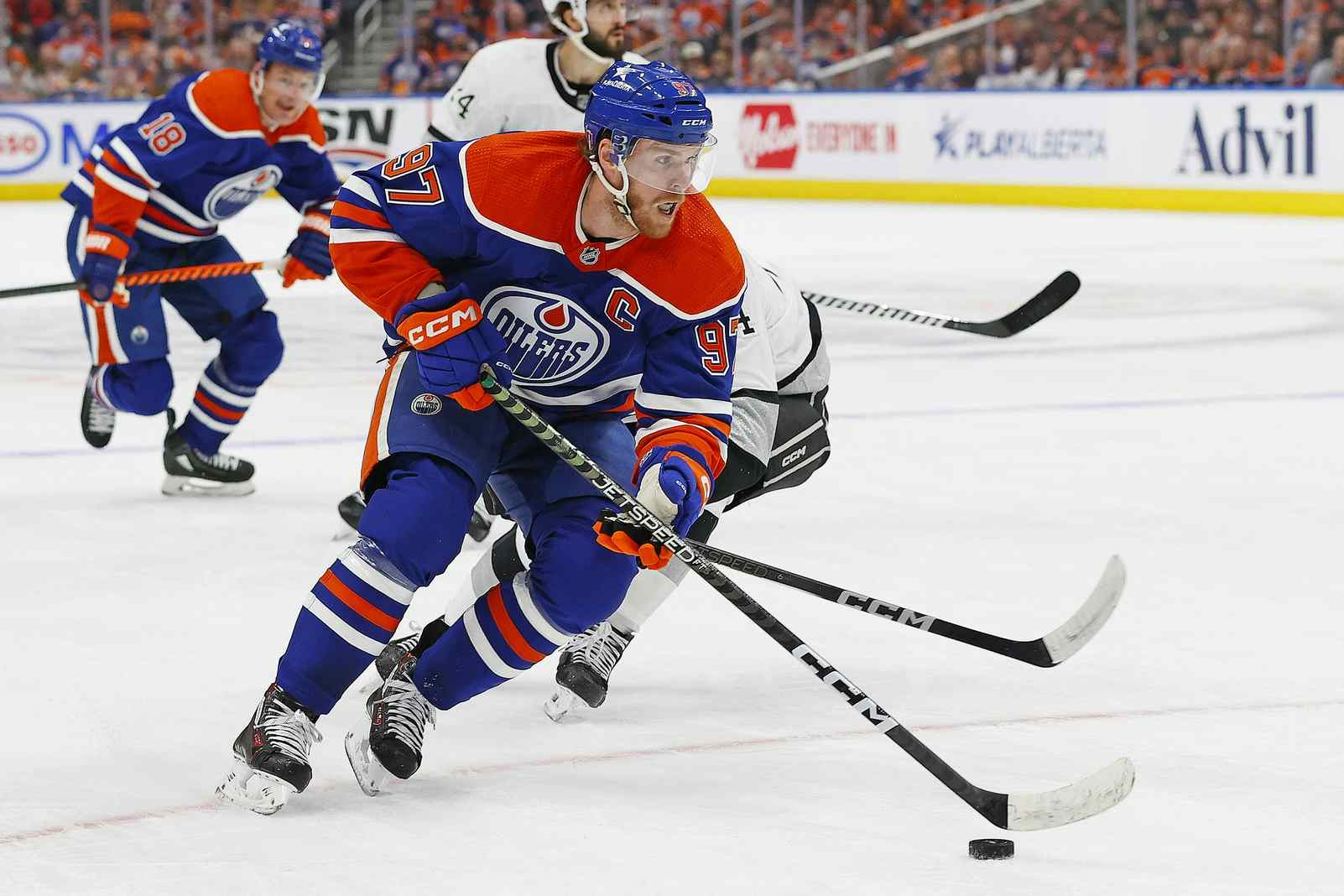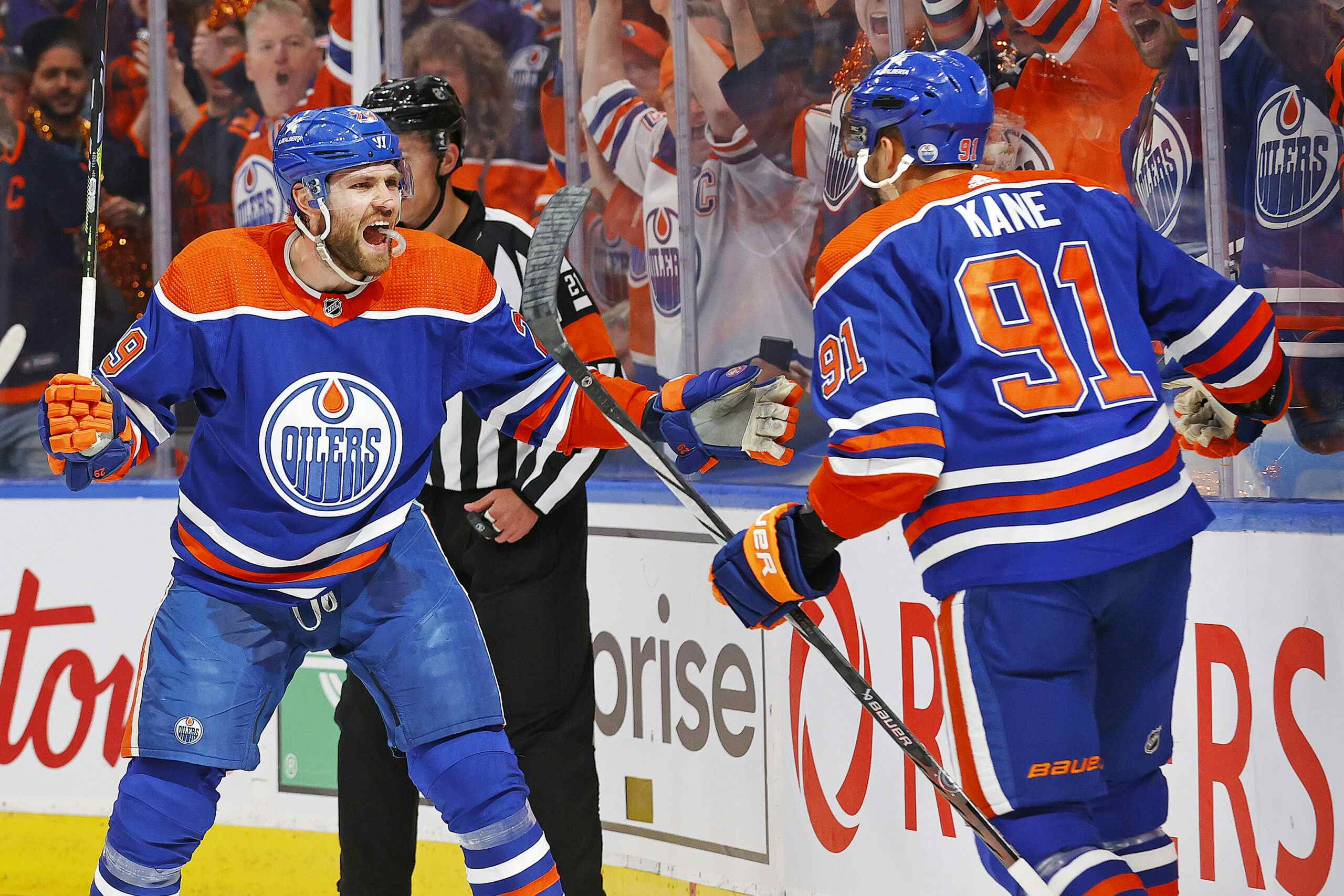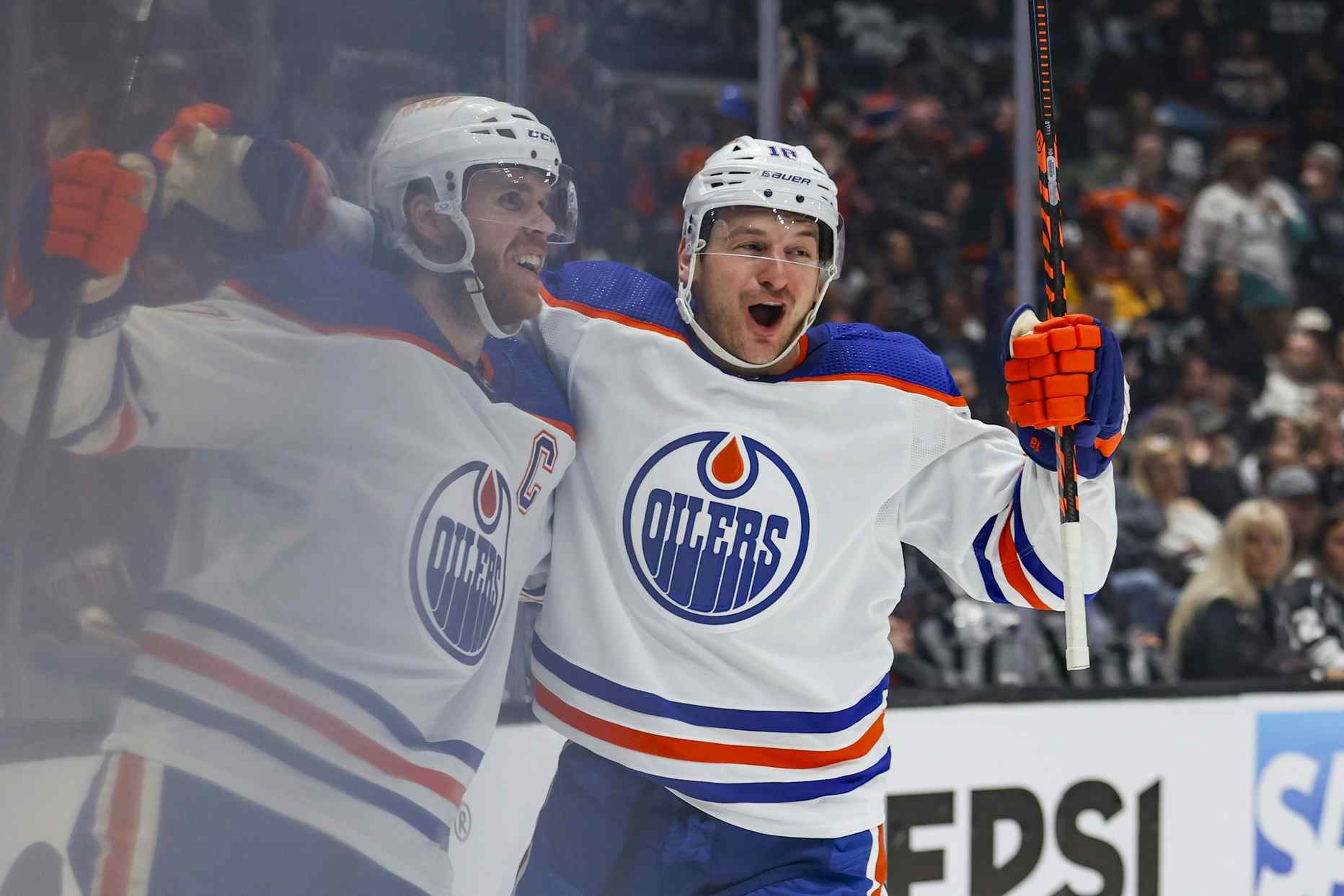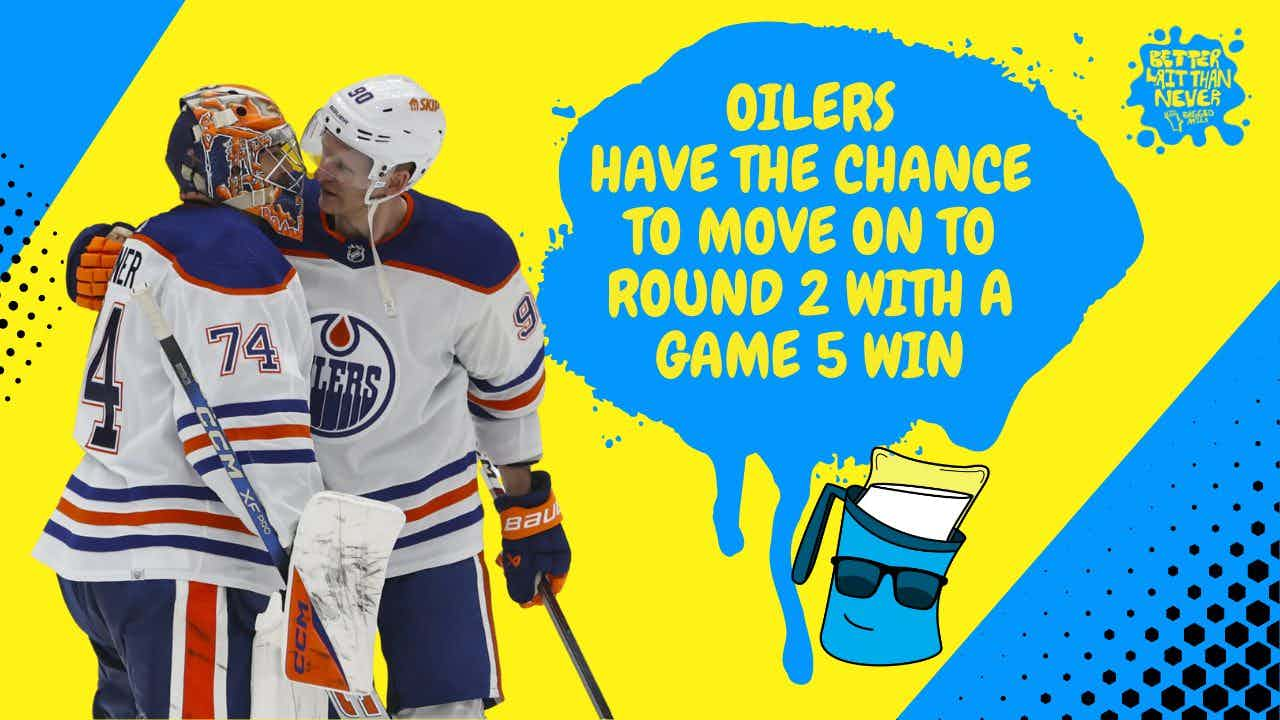Oilers Young Stars Game One: The Tkachev Show

The Nations Network sent this Jets Nation writer to the Young Stars Tournament in Penticton, BC. I’m judging your team and bringing you the view from the Press Box.
The Oilers kicked things off against the local Canucks in dominant fashion, using their forecheck to take a 1st period lead on the shot clock 17-3. It was the Oilers’ forward skill that was the difference to that point. The Canucks opened the game in a 1-4 neutral zone trap and managed their bench throughout to avoid having their invite-heavy roster exposed under the pressure of the Oilers’ older, more skilled roster.
Inside we’ll begin where we left off last year – systems stuff at the top and then a review of every player to follow. You can see the game on YouTube here.
Team Play
The Oilers’ Young Stars used three separate systems in last year’s tournament, struggling to implement the swarm we expected to see (kinda like the real Oilers!). This tournament opened with a very up-tempo, aggressive 2-1-2 that trapped the Canucks’ defenders badly. In the typical 2-1-2 we see two forwards below the bottom of the circles. In a conservative system like Minnesota, we see the players track above the puck. In the Oilers system last night, we saw them attack toward the puck, with the back-side or weak-side forward filling into the high space when necessary. It meant a constant barrage of bodies and sticks when the Canucks squad is still using name tags at team meals.
In the defensive set-zone, the Oilers used what we saw at the end of last year’s tournament, which is a pretty simple centre-low zone. Wingers cover points, defenders are responsible for below the goal line with centre support. Their centres have limited range in this tournament (and none of them can fit in a single corner of a hockey rink anyway), so it makes sense to keep their zone small, mostly the low slot to a few feet past the goal line in this game.
Special teams included the now standard set of centre-post umbrella on the powerplay and an expanding box on the PK. The Canucks attempted a 2-3 umbrella formation on the powerplay (where two players are in front and three freely rotate at the top of the zone) before abandoning it after the 1st period. It caused all sorts of confusion at the top of the zone and Oiler penalty killers didn’t have do much. In transition, the Oilers PK used a 1-1-2 with pressure to the top of the circles, but we may see a 1-3 develop through the tournament.
Defence
#1 Laurent Brossoit: Brossoit showed some very positive skills and some weaker ones. His lateral movement is strong, he tracks the puck in open zone play very well, and he makes first saves with ease thanks to strong angles and positioning. He struggles with tracking the puck into and away from his body a bit and gave up a lot of rebounds. He didn’t seem flustered by it, and I tried to remind myself that it’s a style as he adjusted to be in front of the puck continuously. But in moving up levels, he’ll have to start reeling in more pucks.
#74 Darnell Nurse: What a strange game for Nurse. He played on his off-side with Gernat and was mostly a mess. His gaps were wide open to the point where you might mistake him for being uninterested. We’re used to him calling for the puck and aggressively moving it up the ice, but even that was missing most of the time. He lost containment in his own end and would just float back to the front. He looked lean and didn’t engage physically. We know he has explosive skating and a lot of skill with the puck. A stick break ended one of his chances to show it.
#78 Martin Gernat: This pairing just didn’t work, and neither player looked like himself. Gernat’s passes were poor. His blue line work wasn’t what we’ve come to expect, as he was unwilling to move laterally around blockers. His gaps have always been large as he’s not interested in physical contact in transition, but his skating and stick are good enough to compensate at this level. Just a weird one.
#79 Dillon Simpson: This was my first viewing of the player and he was very different than I expected. He looks and plays bigger than 6’1″ 195lbs. His game is very polished, with stick length gaps from offensive blue line back, constant communication, and tracking his man. He’s composed with the puck, but has less offence than I thought. His outlet is strong, but he doesn’t support up ice very actively and didn’t show a lot in managing the blue line. Slightly different skill set, but about the level we saw from Brandon Davidson a year ago. Still a very positive game while wearing the Oilers’ “C”.
#82 Jordan Osterle: Simpson’s partner showed well, and my brain immediately thought of Taylor Fedun. His stance is a little higher than Fedun, but he’s a smooth skater and passer, has a compact and efficient shot, and has the range to avoid contact most of the game (though isn’t afraid of it). It was a good showing despite a few errors with the puck and some missed reads without it. Simpson covered for him a bit, but Osterle made a case as a competent puck managing defenceman.
#83 Connor Boland: Easily the most limited defender in terms of skills on the team. He made conservative reads to keep the play in front of him. He didn’t lack for foot speed, but did lack in power in small space skating and transition strides. Couldn’t expect more than an outlet pass from him.
#87 David Musil: An outstanding game for Musil. He was easily the smartest of the Oiler defenders, reading a number of different Canucks looks successfully. His skating has come a long way in just one year, and his neutral zone gaps have closed as a result. The best defender along the boards and in front of the net. Musil and Simpson were the only defenders using a box out position consistently. At one point, the Canucks transitioned in an overload with all three forwards on one side of the ice. Boland had to back down, but Musil came across to break up the play at the blue line by crashing the passing lane between them and pushing a player offside.
Forwards
#36 Mitch Holmberg: The free agent addition is supposed to bring some pure scoring skill. He did not bring that to this game. He looked a little like Andrew Miller did a year ago – average at most things, but not a stand out in any particular skill. His timing was quite poor and he was checked while standing still waiting for something to develop a couple times. The second time was on the PP and he battled to get it back. I expect him to improve over the course of the weekend. Seemed a little lost, despite the net being in the same place. In his own end, played way too loose on his check, opening up shooting lanes from the point and re-cycle passes out of the corners.
#39 Bogdan Yakimov: One of three hulking centres for the Oilers, Yakimov distinguished himself as the most polished. He’s a tank in traffic, nearly impossible to knock off the puck and comfortable with his stick into his feet. He makes simple plays, but continues to move the puck and then find space. Simple mantra, but necessary for creating offence. Heavy shot with a quick release. I’d like to see him use it more in this tournament as he was credited with just one shot on net. Lacks straight ahead speed and is not explosive.
#42 Marco Roy: Roy was electrifying, breaking open gaps with his speed and explosive first step. His time with the Jones brothers showed what he can do with help. One-touch passes, open space cycles, and tons of chances. His skating is very high level for this tournament, and his hands are incredible. His third period deke through McEneny was sublime. My mouth was literally open. Strangely, for a second tournament in a row, the Oilers’ staff want to isolate him and he ended up with Khaira and Holmberg, who were much less effective help.
#49 Kale Kessey: I don’t see it with this player. His attack angles were poor. He charged right past his check on one play to hit a defender and was (of course) caught behind the play. He didn’t add offence, he didn’t add grit in any effective way, and he didn’t make things harder for the Canucks. His skating is average to above average for the tournament. He relishes contact, but it’s like playing short handed. He was put with the Jones brothers in the third and I honestly think it was to even out the lines because the Jones’s could carry the load.
#53 Mitch Moroz: Scored two goals, but almost incidental to his game. The first was a powerplay stuff-in from beside the net on a weird, broken play. The second was a tap-in that Marco Roy created to win the game in OT. As I said on Lowdown, he scored from there because he didn’t manage the rest of the ice well. Even that was generous, as he baubled a perfect pass from Draisaitl in the slot. He doesn’t defend inside out, he just crashes at people. He’s good along the boards, but can’t create anything off of them. He can take and make a pass, as LT is fond of saying. But that’s about the limit to his hockey player skills. Skating is good for this tournament, a little more mobility than Kessey. One hope Oilers fans have is that pro hockey provides him the structural discipline to be an effective 10-goal, 60PIMs kind of player.
#54 Jujhar Khaira: This man is So big. He’s listed as smaller than Yakimov, but he looks like a wall on skates. A big, mean wall. Truthfully, he didn’t have an effective game. He was with Kessey and Holmberg to start the game. That line was poor. He played with Tkachev for a spell and Tkachev did all the defensive work on the line and created the offence. He also got Marco Roy for a while. We’ll have to see him away from Holmberg, and I’d like to see him on the wing where he can use his size a little more often (to destroy the boards or crush New York city or whatever). His skating is too limited at this moment for him to be a rangy centre, and in a tournament like this, there isn’t enough structural support to let him be something else. By giving him a smaller area to manage, we might see Khaira become more engaged and effective.
#55 Leon Draisaitl: Another large man, but perhaps a bit top heavy. His stance is too wide to generate power, and unlike Hall (who also had a wide stance), he doesn’t sit down into it. Very straight up skater. I commented that he was faster with the puck than without, and I think it’s true. I think with the puck, he tends to bring is feet closer together and lean down a little more. He looks like a dynamic skater without the biscuit and a plodding one with it. Was caught a few times away from his defensive assignment as a result. His passing is a plus, but he didn’t really want to do it. Spent a lot of time with the puck, couldn’t get his head up for most of the game. Constantly trying to muscle toward the net, which – while he could do it – wasn’t always the best play to try. Chase supported him well, Moroz was no help.
#61 Jackson Houck: A disappointing game. It was a high paced affair, so perhaps he was just somewhat exposed. Tkachev had to do his defensive work, and Houck was only noticeable in the moments when Vancouver turned it up ice and Houck was going to be the last one back. That included a time when Tkachev was the lead forechecker and Houck skated past him at the same Canuck. I didn’t think he brought a lot of offence, but maybe with some structure he could add some positional contributions. Has the stick skills to score and can pass. Feet are slow, stance is broad, and he was behind the play mentally.
#64 Vlad Tkachev: You cheated if you just scrolled straight to this name. The best players for the Oilers were the Jones brothers and Tkachev. The Jones brothers each have four years of college experience and played together. Tkachev was bailing out older, more experienced players with more pedigree, and then created buckets of offence at the other end. His skating is shifty but forceful. He was physical in defensive transition. Didn’t spend much time defending in-zone at all. Passing is excellent, vision exceptional, and his anticipation is his best feature. It is a mystery he didn’t get drafted, and it’s a huge coup that the Oilers have him at camp when 29 other teams could use his skill.
#66 Connor Jones: As I said above, the Jones brothers were the Oilers’ best players. They played together most of the game, including being an effective PK unit and delivering offence with even Kessey bolted on their wing. Connor (the centre) was a little more reckless and little less stable on his skates. He played end board to end board, was physical and most of all, relentless. Showed pro level body positioning and puck awareness. Managed passing lanes well, managed options well. Attacked vertically, horizontally, and in rotation. Smart, smart hockey player who gave everything on each shift.
#72 Greg Chase: This guy is a blast to watch live. He makes the other team crazy. Quick picks create space for his teammates, unnecessary stick work distracts and creates retaliations. But the thing with Chase is his skill. Last season I thought his skating held him back. This game, he literally danced through traffic. Everyone is trying to take his head off, and Chase is the only one playing hockey. He kept the play alive for Draisaitl with keen awareness on the forecheck. He used his body well. He’s a strong passer and can both create and finish plays. At his best when he’s really involved in the play.
#81 Kellen Jones: This Jones is the scorer by reputation, and was a little more patient with the puck. Still, a terrific defensive effort. His board play is pro level, and he created zone exits with good defensive timing and decisive lane closures. Could have had a couple goals, including on a break in the third when he ran the goalie after being stopped. That came after Corrado hit Connor Jones. Kessey then ran Valk and Kellen ran Lotz. It’s a team game.
Recent articles from Kevin McCartney





